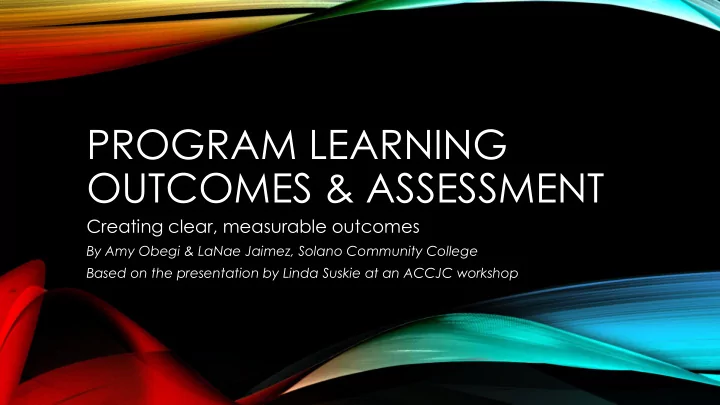

PROGRAM LEARNING OUTCOMES & ASSESSMENT Creating clear, measurable outcomes By Amy Obegi & LaNae Jaimez, Solano Community College Based on the presentation by Linda Suskie at an ACCJC workshop
LEVELS OF ASSESSMENT • Accreditation requires that colleges assess learning at multiple levels: • Course – Student Learning Outcomes (SLOS) • Degree/Certificate – Program Learning Outcomes (PLOS) • General Education – General Education Learning Outcomes (GELOS) • College – Institutional Learning Outcomes (ILOS) • Objective is to articulate goals for student success and measure if students are achieving those goals. If not, planned actions are put into place to support teaching and learning, and program improvement.
PROGRAM LEARNING OUTCOMES (PLOS) • Designed to articulate what skills and/or knowledge faculty want students to obtain at program completion. It is the skill set someone would have walking across the graduation stage at the associate’s or certificate level. • T he PLOs need to be “mastered” in some course(s) in the program • They are the “big” things you want to student’s to learn, and are broader than SLOs. • The skills are developed over multiple courses • Ideally there should be 3-4 measurable PLOs for each program • They are published in the catalogue and should be in written material about the degree or certificate
SIX COMPONENTS OF WELL- CONCEIVED & WRITTEN PLOS 1. Clear – Written succinctly so students can understand 2. Observable/Measurable – If you can see it, you can assess it. Look at action/higher level words on bloom’s taxonomy, and only include one measurable outcome per PLO. Avoid phrases like “Understand the importance of …” which is hard to measure 3. Skills – There should be more PLOs related to skill obtainment than knowledge obtainment 4. Transferable skills – Focus more on what students will be using after they graduate than specific tasks from the program. For example, rather than saying “write a coherent five paragraph essay,” say “write in an organized and clear manner to make a reasoned argument” 5. Relevant – Choose PLOs that are the most representative of discipline goals for success in the field/industry 6. Rigorous yet Realistic – PLOs should be obtainable at program completion
EXAMPLES OF WELL-WRITTEN PLOS • “ Use technology effectively to create visual artworks ” Digital Media at Hawaii • “ Successfully solve business related mathematical computations ” Business Administration at Victor Valley • “ Design gardens that demonstrate the aesthetic principles of unity, repetition, balance, color and texture congruent with customer’s desires” Agriculture at Hawaii • “ Apply critical thinking skills in analysis and evaluation of literature ” English at Passaic
EXAMPLES OF POORLY WRITTEN PLOS • Students will successfully complete required courses for major • Students will demonstrate an understanding of the context of individual development including the centrality of family, culture, and community. Students will develop specific techniques for creating meaningful relationships between home and school. • Apply basic investigative proficiencies How might we improve these?
GROUP/INDIVIDUAL WORK • Review the PLOS published in the catalogue for your program. Do they meet the 6 criteria for well written PLOS? How might you rewrite/rework them to capture program learning goals? • In what courses/assignments should these PLOS be measured? Is there a capstone course? If not, be specific about which classes and which assignments would assess the PLO. • Consider who teaches the courses in which the assessments take place. How will these faculty be made aware of their role in collecting data and reporting on student success. Who will develop planned actions when change is required?
ASSESSING PLOS • PLOs can be measured through well-constructed exams, projects, performances, internship/field experiences, portfolios, and papers (or combinations thereof) • If a program has a capstone class, this is the ideal place to measure PLOs. PLOs should NOT be measured in elective courses as everyone doesn’t take them. Typically, they should also not be measured in entry level (foundation courses), since they are showing student’s work at the beginning of the program, not after cumulative learning. They can be measured in multiple assignments across courses. • Program courses should be mapped to see how they are supporting the development of the PLOs • Rubrics are an excellent way to collect data on student performance on the tasks required for PLO assessments • When reporting PLO results, summarize the strengths & weakness of students as well as quantitative findings
Good assessments should be useful to teachers, students, and the department. Important pedagogical discussions come from faculty coming together to decide what they want their learning outcomes to be. Mapping how students will achieve the outcomes adds coherence to the program.
WHAT IS A PROGRAM? • Degree programs have coherence, depth, and synthesis; they are not just a collection of entry- level classes. Student’s skills should build in a sequence of classes that help them think critically and obtain depth of understanding in the discipline. Students should get out of a program: 1) knowledge of discipline, 2) “hard” career skills, 3) “soft” transferable skills and 4) attitudes, values, dispositions and habits of mind. • - Linda Suskie, March 2016
Recommend
More recommend